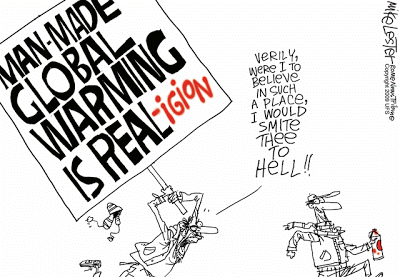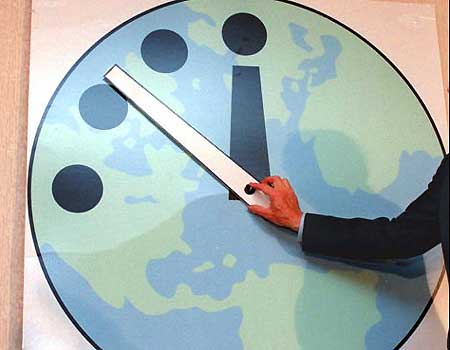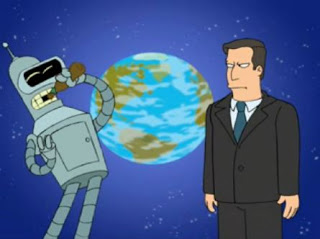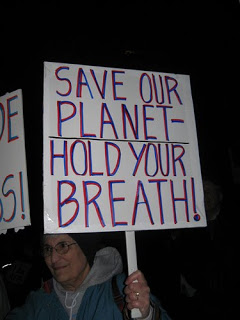
By Will AlexanderI was in the process of packing my bags for home when there was another explosion on the Internet. The IPCC’s claim that climate change will result in massive melting of the Himalayan glaciers is false. This was disclosed in the UK Sunday Times and rapidly spread to other newspapers and the Internet. The Australian carried a headline article yesterday (Monday) and a full page plus two other articles in this morning’s edition.
This claim is the centrepiece of the IPCC assessment reports as well as Al Gore’s documentary An inconvenient truth.
The IPCC has repeatedly maintained that its conclusions are based on peer-reviewed papers in recognized scientific journals. It has now been disclosed that this claim never passed through the peer-review process.
The following is my summary of the sequence of events derived from media reports of the past two days.
1996. A member of the Russian Academy of Sciences predicted significant Himalayan glacier melting by 2350. Somewhere along the line this was fraudulently transformed to 2035.
1999. An Indian glaciologist Sayed Hasnain speculated in a short telephone interview with the New Scientist that all the glaciers in the central and western Himalayas could soon start disappearing. He did not mention the year of 2035 in his interview.
2005. The environmental group WWF published a report in which it described the New Scientist report as disturbing.
2007. The IPCC published its fourth assessment report. One of the report’s central claims was that the world’s glaciers are melting so fast that those in the Himalayas could vanish by 2035. It sourced this prediction to the WWF report.
2009. The Indian government reported that there was no substance in claims of large scale melting of the glaciers. The chairman of the IPCC described his government’s report as voodoo science. He has since been widely criticised for his statement.
2010. Hasnain revealed in an interview with the New Scientist that he had never repeated the prediction in a peer-reviewed journal as it was speculative.
There has been no official response to this issue by the IPCC. It cannot afford to remain silent, particularly after the Climategate exposures and the failure of the Copenhagen discussions.
News headlines
When the Climategate scandal broke, the public had difficulty in appreciating its significance. However, Himalayan glaciers like polar bears are readily appreciated. Can the IPCC survive yet another challenge to its scientific honesty and integrity?
The following are some headlines during the past two days.
IPCC IN TROUBLE OVER FALSE CLAIM.
IPCC MISLED WORLD OVER HIMALAYAN GLACIER MELT DOWN.
CLIMATE SCIENCE ON THIN ICE.
GLACIERGATE COULD NOT HAVE COME AT A WORSE TIME FOR THE UNITED NATIONS PEAK BODY ON CLIMATE.
UNITED NATIONS BLUNDER ON GLACIERS EXPOSED.
MELTING CLAIM BASED ON SPECULATION.
UNITED NATIONS GLACIER BLUNDER A 300-YEAR MIX-UP.
UK Sunday Times article
The following is the original exposure in the UK Sunday Times as reported in CCNet of 18 January.
(1) IPCC MISLED WORLD OVER HIMALAYAN GLACIER MELTDOWN
The Sunday Times January 17, 2010
http://www.timesonline.co.uk/tol/news/environment/article6991177.ece
Jonathan Leake and Chris Hastings
A warning that climate change will melt most of the Himalayan glaciers by 2035 is likely to be retracted after a series of scientific blunders by the United Nations body that issued it.
Two years ago the Intergovernmental Panel on Climate Change (IPCC) issued a benchmark report that was claimed to incorporate the latest and most detailed research into the impact of global warming. A central claim was the world’s glaciers were melting so fast that those in the Himalayas could vanish by 2035. In the past few days the scientists behind the warning have admitted that it was based on a news story in the New Scientist, a popular science journal, published eight years before the IPCC’s 2007 report.
It has also emerged that the New Scientist report was itself based on a short telephone interview with Syed Hasnain, a little-known Indian scientist then based at Jawaharlal Nehru University in Delhi. Hasnain has since admitted that the claim was “speculation” and was not supported by any formal research. If confirmed it would be one of the most serious failures yet seen in climate research. (My emphasis.) The IPCC was set up precisely to ensure that world leaders had the best possible scientific advice on climate change.
The IPCC’s reliance on Hasnain’s 1999 interview has been highlighted by Fred Pearce, the journalist who carried out the original interview for the New Scientist. Pearce said he rang Hasnain in India in 1999 after spotting his claims in an Indian magazine. Pearce said: “Hasnain told me then that he was bringing a report containing those numbers to Britain. The report had not been peer reviewed or formally published in a scientific journal and it had no formal status so I reported his work on that basis.
“Since then I have obtained a copy and it does not say what Hasnain said. In other words it does not mention 2035 as a date by which any Himalayan glaciers will melt. However, he did make clear that his comments related only to part of the Himalayan glaciers. not the whole massif.”
The New Scientist report was apparently forgotten until 2005 when WWF cited it in a report called An Overview of Glaciers, Glacier Retreat, and Subsequent Impacts in Nepal, India and China. The report credited Hasnain’s 1999 interview with the New Scientist. But it was a campaigning report rather than an academic paper so it was not subjected to any formal scientific review. Despite this it rapidly became a key source for the IPCC when Lal and his colleagues came to write the section on the Himalayas.
When finally published, the IPCC report did give its source as the WWF study but went further, suggesting the likelihood of the glaciers melting was “very high”. The IPCC defines this as having a probability of greater than 90%.
The report read: “Glaciers in the Himalaya are receding faster than in any other part of the world and, if the present rate continues, the likelihood of them disappearing by the year 2035 and perhaps sooner is very high if the Earth keeps warming at the current rate.”
However, glaciologists find such figures inherently ludicrous, pointing out that most Himalayan glaciers are hundreds of feet thick and could not melt fast enough to vanish by 2035 unless there was a huge global temperature rise. The maximum rate of decline in thickness seen in glaciers at the moment is 2-3 feet a year and most are far lower.
Professor Julian Dowdeswell, director of the Scott Polar Research Institute at Cambridge University, said: “Even a small glacier such as the Dokriani glacier is up to 120 metres [394ft] thick. A big one would be several hundred metres thick and tens of kilometres long. The average is 300 metres thick so to melt one even at 5 metres a year would take 60 years. That is a lot faster than anything we are seeing now so the idea of losing it all by 2035 is unrealistically high.”
Rajendra Pachauri, the IPCC chairman, has previously dismissed criticism of the Himalayas claim as “voodoo science”.
Last week the IPCC refused to comment so it has yet to explain how someone who admits to little expertise on glaciers was overseeing such a report. Perhaps its one consolation is that the blunder was spotted by climate scientists who quickly made it public.
The lead role in that process was played by Graham Cogley, a geographer from Trent University in Ontario, Canada, who had long been unhappy with the IPCC’s finding.
He traced the IPCC claim back to the New Scientist and then contacted Pearce. Pearce then re-interviewed Hasnain, who confirmed that his 1999 comments had been “speculative”, and published the update in the New Scientist.
Cogley said: “The reality, that the glaciers are wasting away, is bad enough. But they are not wasting away at the rate suggested by this speculative remark and the IPCC report. The problem is that nobody who studied this material bothered chasing the trail back to the original point when the claim first arose. It is ultimately a trail that leads back to a magazine article and that is not the sort of thing you want to end up in an IPCC report.”
Pearce said the IPCC’s reliance on the WWF was “immensely lazy” and the organisation need to explain itself or back up its prediction with another scientific source. Hasnain could not be reached for comment.
The revelation is the latest crack to appear in the scientific consensus over climate change. It follows the so-called climategate scandal, where British scientists apparently tried to prevent other researchers from accessing key date. Last week another row broke out when the Met Office criticised suggestions that sea levels were likely to rise 1.9m by 2100, suggesting much lower increases were likely.
Copyright 2010, TST
Cease fire
I have received instructions to call it a day and get on with packing my bags.
Via email
 By Alan Caruba
By Alan Caruba Al Gore dialed down the rhetoric, ahem,
Al Gore dialed down the rhetoric, ahem,  from Star Trek 6 ‘the undiscovered cucumber’
from Star Trek 6 ‘the undiscovered cucumber’





 The latest boil to burst forth upon the body of environmental journalism began to fester on Thursday, January 7, when the USEPA announced that it was proposing the latest, greatest and most-badly- needed-ever smog standard. (Officially the pollutant is “ground-level ozone”, but we’ll stick with “smog” for convenience). Mainstream media outlets everywhere fell over themselves to heap praise on the EPA for imposing a standard that administrator Lisa Jackson described as “long overdue.” This lead, from the Chicago Tribune’s lead environmental reporter/head Sierra Club cheerleader
The latest boil to burst forth upon the body of environmental journalism began to fester on Thursday, January 7, when the USEPA announced that it was proposing the latest, greatest and most-badly- needed-ever smog standard. (Officially the pollutant is “ground-level ozone”, but we’ll stick with “smog” for convenience). Mainstream media outlets everywhere fell over themselves to heap praise on the EPA for imposing a standard that administrator Lisa Jackson described as “long overdue.” This lead, from the Chicago Tribune’s lead environmental reporter/head Sierra Club cheerleader  The three CASAC members who sport public health credentials are:
The three CASAC members who sport public health credentials are: